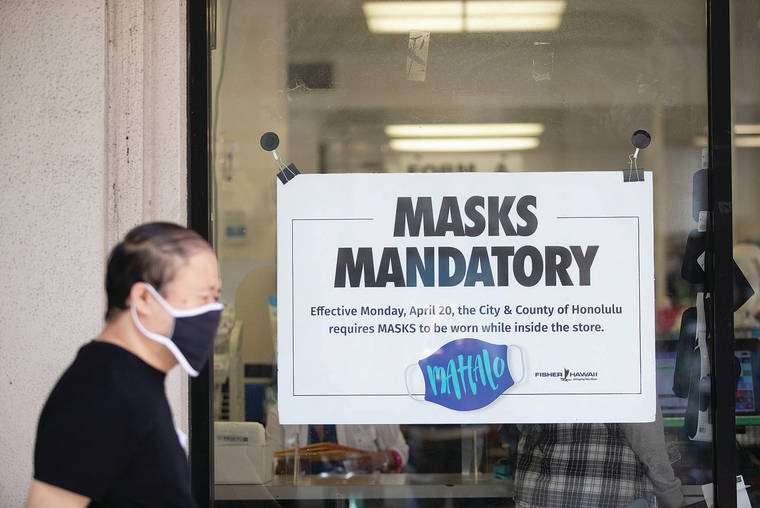Should Oahu’s tiered reopening plan receive a public hearing?

CINDY ELLEN RUSSELL / CRUSSELL@STARADVERTISER.COM
A man last week walked past a mask mandate sign in the window of Fisher Hawaii downtown.
Former Mayor Kirk Caldwell rolled out Oahu’s tiered reopening plan in September as an emergency measure to guide the lifting of COVID-19 restrictions. Six months later the island is still adhering to the plan, which has not received any official public hearings.
If the tier system were to go through the same process as other bills to become law, University of Hawaii Director of Public Policy Colin Moore explained that it would have taken months to be implemented, which was time the city did not have.
“It was put into place for good reason to protect us. But it was an emergency measure,” he said.
“I think the question is, At what point after the immediacy of the emergency passes do we need to start public consultation and figuring out what’s working and what’s not?”
The plan itself was approved by Gov. David Ige, and any time the city wants to move to a different tier, it again needs his approval.
Mayor Rick Blangiardi moved the city into Tier 3 of the reopening plan at the end of February, and modified it this week to allow organized sports to restart, bars to reopen and funerals to have no attendance limit as long as 6-foot distancing is maintained.
Don't miss out on what's happening!
Stay in touch with breaking news, as it happens, conveniently in your email inbox. It's FREE!
Councilwoman Andria Tupola worked with the mayor and state officials to get organized sports, especially youth programs, to be part of Tier 3. Originally, sports were allowed only in Tier 4.
“If you didn’t like a state law, you could go to your lawmaker, say, ‘Hey, propose this bill or fight against this departmental policy I don’t like,’ but with the tiers, what are you going to do?” she asked.
“There’s not really a process where you can get your voice heard, and we’ve never had emergency proclamations last for this long. So it’s been pretty daunting for people who feel like they’re being unfairly targeted, or even financially hit, to even have a voice.”
The wedding industry was particularly hard-hit due to the restrictions, which in Tier 2 allowed only five people to gather for weddings, and in Tier 3 allows only 10 people.
Julie Aragaki, who owns Best Hawaii Wedding, a company that does property management and event coordination for weddings, was disappointed when Blangiardi said restrictions on weddings would not be modified in Tier 3.
She worried that because there is no time frame for how long it would be until the 10-person limit would be lifted, brides would stop postponing their weddings and just cancel them instead.
“What’s happening because of that is the refunds need to be distributed,” she said.
“So if every vendor now has to refund, we were on the verge of going out of business. This will really set us over the top.”
Throughout the pandemic, she, along with other wedding professionals, put together phased plans to reopen safely and submitted multiple documents and a video to government officials, but have not yet received a response. One of the main constrictions of the 10-person limit is that it includes vendors. It means a wedding with a coordinator, officiant, photographer, videographer and musician can only have five people attending the wedding.
“We’re all independent businesses, and we’re not really represented by a large merchants association or a restaurant association,” Aragaki said. “We’re all these little voices that really do not have a big voice. So I think that’s kind of where the problem sits.”
She and others in the industry hope to show Blangiardi that weddings can be controlled by professionals.
“If you do have wedding professionals in place to be able to monitor everything, the safety, I think it is going to be sometimes a lot safer than if you went to some of the restaurants that are not implementing protocols as diligently as they should be,” Aragaki said.
Another industry that wants modifications to the tier system is fitness studios that teach group classes.
Yoga Room Hawaii owner Paula Colletti noticed a positive change in the studio being allowed to teach classes of nine with a teacher in Tier 3, but did not understand why the 50% capacity rule that applies to open-floor gyms did not apply to class-based studios.
“Originally, it was restaurants that can open with no capacity. Now bars can open up again socially distanced. We all know the reality of what that actually looks like,” she said.
She estimated that by maintaining social distancing, the studio could accommodate 21 students in the room.
Colletti has not heard back from the government officials she has written to about the tier system, but would “absolutely” participate in a public hearing if it was available.
Moore explained that it is unclear whether it would be up to the state Legislature or City Council to hold a public hearing for the tier system, but it would offer an opportunity for public-health officials to explain the reasoning behind the decisions.
“Just because the public thinks something doesn’t make sense, doesn’t mean it doesn’t make sense from a public-health perspective,” he said.
“Something public hearings help to solve is that it can provide opportunities to communicate why these restrictions are the way they are.”
Blangiardi explained that his administration has been trying to respond to people’s complaints and that the recent modifications are a reflection of that.
“I would always like to listen to the public,” he said.
“But you know, at the end of the day, we’ve said repeatedly the State Department of Health makes the rules. … We don’t have the final say.”



